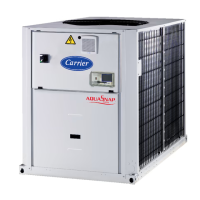48
The water connections on the desuperheater water inlets and
outlets must not cause any mechanical local constraint at the
heat exchangers. If necessary, install exible connection sleeves.
Install water ow control and balancing valves at the heat
exchanger outlet.
The volume of the desuperheater circuit water loop must be
as low as possible so that the temperature can increase rapidly
when the unit is started up.
The minimum entering water temperature at the desuper-
heater is 25°C. This requires the use of a three-way valve (item
31 in the diagram), with a controller and the sensor controlling
the minimum required entering water temperature.
The desuperheater water loop must include a relief valve and
an expansion tank. When selecting these, consider the water
loop volume and the maximum temperature (90°C) when
pump operation is stopped (item 20 in the diagram).
option
The unit can operate in two modes.
18.4.1 - Efciency priority mode (standard)
In this mode unit control optimises unit efciency. Heat
reclaim is based on the saturated condensing temperature.
The percentage of the reclaimed heating capacity compared
with the total capacity rejected by the condenser increases
in proportion to the saturated condensing temperature. This
temperature is directly linked to the condenser entering air
temperature (entering air temperature in cooling mode and
water temperature in heating mode).
18.4.2 - Reclaim priority mode
In cooling mode only this conguration allows the user to
enter a setpoint that is relative to the minimum condensing
temperature (default = 40°C) to increase the heating capacity
reclaimed at the desuperheaters, if required. This conguration
is only effective if the desuperheater contact is activated on
the control board (user connection block). This function is not
available for 30RQSY units.
For setpoint control of the minimum saturated condensing
temperature and to nd the position of the connection block
on the board refer to the 30RB/RQ Touch Pilot Junior control
manual.
Other parameters directly affecting the effective capacity
reclaimed at the desuperheater are principally:
• The unit load rates, that decide whether the unit operates
at full load (100%) or part load.
• The water entering temperature in the desuperheater
as well as the condenser entering air temperature.
Entering water temperature at start-up °C 25* 60
Leaving water temperature during operation °C 30 65
Outside operating temperature °C -10 46
This option allows production of brine down to 0°C (option
5B) / -15°C (option 6B). The unit is equipped with suction
pipe insulation (option 6B only) and a fan frequency
converter.
The operating range is a function of the suction pressure,
which in turn is a function of:
- the brine type,
- the brine concentration,
- the ow rate,
- the brine temperature,
- the condensing pressure (ambient temperature).
Example: For operation with ethylene glycol at 45% and a
brine temperature of -15°C (entering temperature -10°C), the
maximum outside operating temperature will be around 33°C.
-25
-15
-5
5
15
25
35
45
55
-20-15-10-50510
Outside air temperature, °C
Evaporator leaving water temperature, °C
The evaporator low pressure and frost protection depends
on the amount of antifreeze added to the water circuit. The
evaporator approach (LWT - SST) as well as frost protection
are based on this amount).
It is therefore essential to control the amount of antifreeze
in the water loop at the rst start-up (circulate for 30 minutes
to ensure good homogeneity of the mixture before taking
the sample). Refer to the manufacturer’s data to dene the
frost protection, based on the concentration rate measured.
The frost protection temperature must be used in the unit
software parameters.
Option 5B
Option 6B

